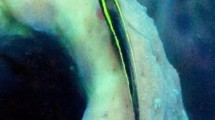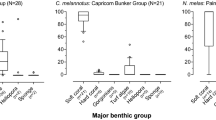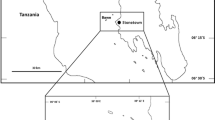Abstract
The common Caribbean starfish Oreaster reticulatus (Linnaeus) feeds on sponges by everting its stomach onto a sponge and digesting the tissue, leaving behind the sponge skeleton. In the San Blas Islands, Republic of Panama, 54.2% of the 1549 starfish examined from February 1987 to June 1990 at eight sites were feeding, and 61.4% of these were feeding on sponges, representing 51 species. Sponges were fed on disproportionately heavily in comparison to their abundance, which was only 9.7% of available prey. In feeding choice experiments, 736 pieces of 34 species of common sponges from a variety of shallow-water habitats, and also 9 ind of a coral, were offered to starfish in individual underwater cages. Acceptance or rejection of sponge species was unambiguous for 31 of the 34 species, and there was a clear relationship between sponge acceptability and sponge habitat. Starfish ate 16 of 20 species that normally grow only on the reefs, but only 1 of 14 species that live in the seagrass meadows and rubble flats surrounding the reefs. The starfish live in the seagrass meadows and rubble flats, and avoid the reefs, and so the acceptable reef sponges are generally inaccessible until a storm fragments and transports them into starfish habitat. After Huricane Joan washed fragments of reef sponges into a seagrass meadow in October 1988, starfish consumed the edible species. When the seagrass meadow was experimentally seeded with tagged reef sponge fragments in June 1994, O. reticulatus consumed edible species and accumulated in the area seeded. Reef sponges that were living in a seagrass meadow, from which O. reticulatus had been absent for at least 4 yr (from 1978 to 1982), were eliminated when the starfish migrated into the area, and the sponges have been unable to recolonize up to June 1994. O. reticulatus feeding and habitat preferences appear to restrict distributions of many Caribbean reef sponge species to habitats without O. reticulatus and may have exerted significant selective pressure on defences of those sponges that live in O. reticulatus habitats.
Similar content being viewed by others
References
Alcolado PM (1979) Ecological structure of the sponge fauna in a reef profile of Cuba. In: Levi C, Boury-Esnault N (eds) Biologie des spongiares. Colloques int Cent natn Rech scient 291:297–302
Alcolado PM (1990) General features of Cuban sponge communities. In: Rützler K (ed) New prerpectives in sponge biology. Smithsonian Institution Press, Washington, D.C., pp 351–357
Alvarez B, Diaz MC, Laughlin RA (1990) The sponge fauna on a fringing coral reef in Venezuela, I: composition, distribution, and abundance. In: Rützler K (ed) New prespectives in sponge biology. Smithsonian Institution Press, Washington, D.C., pp 358–366
Anderson JM (1978) Studies on functional morphology in the digestive system of Oreaster reticulatus (L.) (Asteroidea). Biol Bull mar biol Lab Woods Hole 154: 1–14
Bakus GJ, Thun MA (1979) Bioassays on the toxicity of Caribbean sponges. In: Levi C, Boury-Esnault N (eds) Biologie des spongiares. Colloques int Cent natn Rech scient 291:417–422
Bergmann W (1949) Comparative biochemical studies on the lipids of marine invertebrates, with special reference to the sterols. J mar Res 8:137–176
Bergquist PR (1978) Sponges. University of California Press, Berkeley, Los Angeles
Bergquist PR, Hartmann WD (1969) Free amino acid patterns and the classification of the Demospongiae. Mar Biol 3:247–268
Dayton PK (1979) Observations of growth, dispersal, and population dynamics of some sponges in McMurdo Sound, Antarctica. In: Levi C, Boury-Esnault N (eds) Biologie des spongiares. Colloques int Cent natn Rech scient 291:271–282
Dayton PK, Robilliard GA, Paine RT, Dayton LB (1974) Biological accomodation in the benthic community at McMurdo Sound, Antarctica. Ecol Monogr 44:105–128
Faulkner DJ (1986) Marine natural products. Nat Prod Rep (Lond) 3:1–33
Faulkner DJ (1987) Marine natural products. Nat Prod Rep (Lond) 4:539–576
Faulkner DJ (1988) Marine natural products. Nat Prod Rep (Lond) 5:613–663
Faulkner DJ (1990) Marine natural products. Nat Prod Rep (Lond) 7:269–309
Faulkner DJ, Giselin MT (1983) Chemical defense and evolutionary ecology of dorid nudibranchs and some other opistobranch gastropods. Mar Ecol Prog Ser 13:295–310
Green G, Gomez P, Bakus G (1990) Anti-microbial and ichthyotoxic properties of marine sponges from Mexican waters. In: Rützler K (ed) New perspectives in sponge biology, Smithsonian Institution Press, Washington, D.C., pp 109–114
Hay ME, Fenical W (1988) Marine plant-herbivore interactions: the ecology of chemical defense. A Rev Ecol Syst 19:111–145
Hoppe WF (1988) Growth, regeneration and predation in three species of large coral reef sponges. Mar Ecol Prog Ser 50:117–125
Laubenfels MW de (1950) The porifera of the Bermuda Archipelago. Trans zool Soc Lond 27:1–201
Lewis SM (1985) Herbivory on coral reefs: algal susceptibility to herbivorous fishes. Oecologia 65:370–375
McClintock JB (1987) Investigation of the relationship between invertebrate predation and biochemical composition, energy content, spicule armament, and toxicity of benthic sponges at McMurdo Sound, Antarcitica. Mar Biol 94:479–487
Meylan A (1990) Nutritional characteristics of sponges in the diet of the hawksbill turtle, Eretmochelys imbricata. In: Rützler K (ed) New perspectives in sponge biology. Smithsonian Institution Press, Washington, D.C., pp 472–477
Paine RT (1966) Food web complexity and species diversity. Am Nat 100:65–75
Pawlik JR (1993) Marine invertebrate chemical defenses. Chem Rev 93:1911–1922
Pawlik JR, Kernan MR, Molinski TF, Harper MK, Faulkner DJ (1988) Defensive chemicals of the Spanish dancer nudibranch Hexabranchus sanguineus and its egg ribbons: macrolides derived from a sponge diet. J exp mar Biol Ecol 119:99–109
Pulitzer-Finale G (1986) A collection of West Indian demospongiae (Porifera). Annali Mus civ Stor nat Giacomo Doria 86:65–216
Randall JE, Hartman WD (1968) Sponge-feeding fishes of the West Indies. Mar Biol 1:216–225
Reiswig HM (1973) Population dynamics of three Jamaican demospongiae. Bull mar Sci 23:191–226
Rogers SD, Paul VJ (1991) Chemical defenses of three Glossodoris nudibranchI's and their dietary Hyrtios sponges. Mar Ecol Prog Ser 77:221–232
Scheibling RE (1979) The ecology of Oreaster reticulatus (L.) (Echinodermata: Asteroidea) in the Caribbean. PhD thesis, McGill University, Montreal
Scheibling RE (1980a) Abundance, spatial distribution, and size structure of populations of Oreaster reticulatus (Echinodermata: Asteroidea) in seagrass beds. Mar Biol 57:95–105
Scheibling RE (1980b) Abundance, spatial distribution, and size structure of populations of Oreaster reticulatus (Echinodermata: Asteroidea) on sand bottoms. Mar Biol 57:107–119
Scheibling RE (1980c) Dynamics and feeding activity of high-density aggregations of Oreaster reticulatus (Echinodermata: Asteroidea) in a sand patch habitat. Mar Ecol Prog Ser 2:321–327
Scheibling RE (1980d) Homing movements of Oreaster reticulatus (L.) (Echinodermata: Asteroidea) when experimentally translocated from a sand patch habitat. Mar Behav Physiol 7:213–223
Scheibling RE (1980e) The microphagous feeding behavior of Oreaster reticulatus (Echinodermata: Asteroidea). Mar Behav Physiol 7:225–232
Scheibling RE (1981a) The annual reproductive cycle of Oreaster reticulatus (L.) (Echinodermata: Asteroidea) and interpopulation differences in reproductive capacity. J exp mar Biol Ecol 54:39–54
Scheibling RE (1981b) Optimal foraging movements of Oreaster reticulatus (L.) (Echinodermata: Asteroidea). J exp mar Biol Ecol 51: 173–185
Scheibling RE (1981c) Growth and respiration rate of juvenile Oreaster reticulatus (L.) (Echinodermata: Asteroidea) on fish and algal diets. Comp Biochem Physiol 69A:175–176
Scheibling RE (1982a) Feeding habits of Oreaster reticulatus (Echinodermata: Asteroidea). Bull mar Sci 32:504–510
Scheibling RE (1982b) Habitat utilization and bioturbation by Oreaster reticulatus (Asteroidea) and Meoma ventricosa (Echinoidea) in a subtidal sand patch. Bull mar Sci 32:624–629
Scheibling RE (1985) Directional movement in a sea star (Oreaster reticulatus): adaptive significance and ecological consequences. In: Rankin MA (ed) Migration: mechanisms and adaptive significance. Univ Texas Contr mar Sci 27 (Supplement): 244–256
Schmahl GP (1990) Community structure and ecology of sponges associated with four Southern Florida coral reefs. In: Rützler K (ed) New perspectives in sponge biology. Smithsonian Institution Press, Washington, D.C., pp 376–383
Sheild CJ, Witman JD (1993) The impact of Henricia sanguinolenta (O.F. Muller) (Echinodermata: Asteroidea) predation on the finger sponges, Isodictya spp. J exp mar Bio Ecol 166:107–133
Sloan NA (1980) Aspects of the feeding biology of asteroids. Oceanog mar Biol A Rev 18:57–124
Thomas LP (1960) A note on the feeding habits of the West Indian sea star Oreaster reticulatus (Linnaeus). Q J Fla Acad Sci 23:167–168
Wiedenmayer F (1977) Shallow-water sponges of the western Bahamas. Birkhauser Verlag, Basel
Wulff JL (1988) Fish predation on cryptic sponges of Caribbean coral reefs. Am Zool 28: p 166
Wulff JL (1990) Patterns and processes of size change in Caribbean demosponges of branching morphology. In: Rützler K (ed) New perspectives in sponge biology. Smithsonian Institution Press, Washington, D.C., pp 425–435
Wulff JL (1991) Asexual fragmentation, genotype success, and population dynamics of erect branching sponges. J exp mar Biol Ecol 149:227–247
Wulff JL (1994) Sponge-feeding by Caribbean angelfishes, trunk-fishes, and filefishes. In: Soest RWM van, Kempen TMG van, Braekman J-C (eds) Sponges in time and space. A.A. Balkema, Rotterdam, pp 265–271
Wulff JL (1995) Hurricane effects on survival and orientation of large erect coral reef sponges. Coral Reefs 14:55–61
Wulff JL (in preparation) Mutualism among species of coral reef sponges.
Author information
Authors and Affiliations
Additional information
Communicated by J. P. Grassle, New Brunswick
Rights and permissions
About this article
Cite this article
Wulff, L. Sponge-feeding by the Caribbean starfish Oreaster reticulatus . Marine Biology 123, 313–325 (1995). https://doi.org/10.1007/BF00353623
Received:
Accepted:
Issue Date:
DOI: https://doi.org/10.1007/BF00353623




